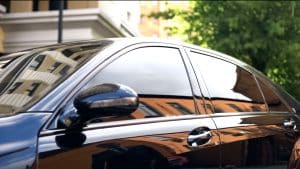Does Window Tint Make You More Likely to Crash?
 Vehicle manufacturers often showcase cars with tinted windows in their advertisements for a compelling reason – it enhances their aesthetic appeal. Window tinting is not limited to sports cars; it offers a versatile option to elevate the appearance of any vehicle. Available in various darkness levels, tinting can impart a sporty, rugged, or sophisticated look to your car.
Vehicle manufacturers often showcase cars with tinted windows in their advertisements for a compelling reason – it enhances their aesthetic appeal. Window tinting is not limited to sports cars; it offers a versatile option to elevate the appearance of any vehicle. Available in various darkness levels, tinting can impart a sporty, rugged, or sophisticated look to your car.
While your vehicle might look good with tinted windows, it is important to understand the risks it poses to not only you but to other drivers as well. If you are in an accident where the window tint may have contributed to the cause of the accident, you may be able to file a lawsuit against the other driver for compensation.
What are the risks of window tint?
Window tinting itself doesn’t inherently make you more likely to crash, but it can potentially contribute to safety concerns if not used responsibly and within legal limits. Here are some factors to consider:
- Visibility. Excessive window tinting, especially on the front windshield and front side windows, can reduce visibility, particularly at night or in low-light conditions. Impaired visibility can increase the risk of accidents, as you may not see pedestrians, other vehicles, or potential hazards clearly.
- Illegal tinting. Missouri has laws (discussed below) regulating the darkness of window tinting to ensure a minimum level of visibility for drivers. Using window tints that exceed the legal limits can result in fines or citations, and it can also pose safety risks if it obstructs your view or makes your vehicle less visible to others.
- Reduced communication. Window tinting, especially if it’s very dark, can make it more challenging for drivers to make eye contact with pedestrians, cyclists, or other drivers. Non-verbal communication through eye contact is an essential aspect of road safety, and reduced visibility may hinder this interaction.
- Tinted windows and emergency response. Emergency responders, such as police officers, rely on visual cues when approaching a vehicle. Heavily tinted windows can make it difficult for them to assess the situation inside a vehicle during traffic stops or emergencies, potentially leading to misunderstandings or delays.
- Hinders escape in an emergency. In emergency situations that require breaking a front window (or side windows) for a quick escape from a vehicle, window tinting can pose challenges. Aftermarket tint typically consists of a robust mylar film that is not easy to tear without a sharp tool, as explained by John Bridgwater, owner of two AAA Approved Auto Repair Centers in the Bay Area and a master mechanic. When using a traditional spring-loaded escape tool, tempered glass windows typically shatter into small cubes for a swift exit. However, the presence of tinting film can impede this process, preventing the glass from breaking as intended.
While your vehicle may look good with tinted windows, you have to consider whether it is worth it when the risks you are taking in having it installed could be disastrous.
What are the benefits of window tint?
Window tinting offers a range of benefits that are often underestimated. Safety is one advantage, especially when considering the materials used in car windows. While windshields are typically constructed from glass-plastic laminate, side and rear windows, as well as sunroofs, are made from tempered glass. In the event of an accident, tempered glass shatters into numerous pieces, posing a threat to vehicle occupants. Your window’s tint may hold these shards together, preventing them from scattering and potentially causing harm.
Security is another noteworthy benefit of window tinting. Many car thefts occur due to opportunities created by visible valuables inside vehicles. Tinted windows obstruct the view of potential thieves, making it challenging for them to identify items like smartphones, wallets, or computers. By concealing your possessions, window tinting reduces the likelihood of your car becoming a target for theft. Unlike alarm systems, which only deter thieves after they’ve attempted a break-in, tinting acts as a preventative measure.
Glare reduction is another practical advantage, even with light tint shades. Tinted windows effectively diminish glare from direct sunlight and reflections off wet roads, buildings, or other vehicles. This results in reduced squinting and an overall safer driving experience.
Window tinting also helps control heat within your vehicle. Without tint, sunlight can turn your car’s interior into a sauna by allowing solar radiation to penetrate. Tint, even in lighter shades, helps maintain a cooler and more comfortable interior temperature. This not only enhances the driving experience but also eases the workload on your air conditioning system, potentially extending its lifespan and reducing fuel consumption.
Lastly, window tinting contributes to health by blocking 99% of UVA and UVB rays, regardless of tint darkness. These harmful rays can degrade your car’s interior surfaces, such as seat upholstery and dashboard materials, and pose health risks such as sunburn and skin cancer.
What are Missouri’s laws on window tinting?
In Missouri, specific regulations govern window tint darkness, with variations between sedan cars and SUVs/vans. The measurement used to determine tint darkness is Visible Light Transmission (VLT). For sedans, windshields can have non-reflective tint above the manufacturer’s AS-1 line, front side windows must allow more than 35% of light in, and there are no specific darkness restrictions for back side windows and the rear window. The rules for SUVs and vans are quite similar, allowing non-reflective tint above the AS-1 line on the windshield, requiring more than 35% of light transmission for front side windows, and having no specific restrictions on darkness for back side windows and the rear window.
Additionally, window tinting in Missouri can reflect incoming light, reducing glare and heat. However, there are limitations on the level of reflection allowed. For both sedans and SUVs/vans, front side windows must not be more than 35% reflective, and the same restriction applies to back side windows.
Missouri’s regulations on window tinting extend to other important aspects. Dual side mirrors are mandated only if the back window is tinted, and no specific colors of tint are explicitly banned. A three percent variance in tint darkness is permitted. Manufacturers of window film are not required to certify the film they sell in Missouri, and there is no mandatory sticker to identify legal tinting. Importantly, Missouri allows medical exemptions for special tint, providing flexibility for individuals with specific medical needs.
If you are in an accident with a driver whose car has tinted windows beyond the legal limits of the state, you may be able to secure compensation with the help of an experienced car accident attorney. At Kansas City Accident Injury Attorneys, we have over 30 years helping car accident victims find justice and receive the restitution they deserve. If you have been in an accident where tinted windows contributed to the crash, we want to help. To schedule a free consultation, call us or use our contact form. Our attorneys can meet with you anytime at our office in Kansas City, MO, or you can schedule an appointment at our offices in Lee’s Summit, Parkville and St. Joseph (MO); Olathe, Kansas City, and Overland Park (KS).

Kansas City personal injury attorney James Roswold of Kansas City Accident Injury Attorneys handles cases dealing with victims of personal injury, medical negligence, wrongful death, workers compensation, nursing home negligence, premises liability, product liability, car accident, truck accident and motorcycle accident cases.

